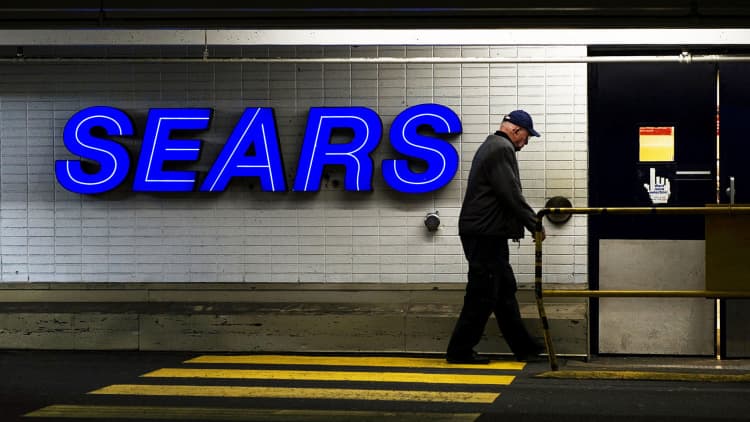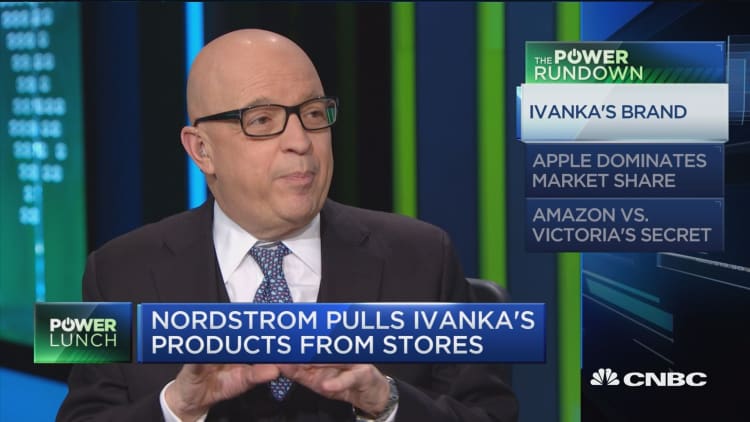
Concerns that Sears is headed toward bankruptcy have been reignited.
The company's shares closed Wednesday down more than 12 percent, falling below $8, after the struggling department store expressed doubt about its future as a retailer.
"Our historical operating results indicate substantial doubt exists related to the company's ability to continue as a going concern," Sears said in an annual filing with the Securities and Exchange Commission.
Sears has been closing stores, selling off assets like its Craftsman brand and borrowing money from CEO Eddie Lampert to survive. The cash injections from Lampert's hedge fund, ESL Investments, and his heavy ownership of the chain's unsecured debt had convinced some investors that it would avoid filing Chapter 11.
If it did, those people reasoned, Lampert would give up control of what was essentially an out-of-court restructuring process. Yet for some, the inclusion of Sears' new language in its SEC filing could be seen as a signal that Lampert's financial spigot could turn off, Joshua Friedman, legal analyst at Debtwire, told CNBC.
"Beforehand the assumption might have been that Sears couldn't file or wouldn't file for bankruptcy," Friedman told CNBC. "When your fears are confirmed to some degree, that's often the signal to some people that the time's right to get out."
Sears, for its part, attempted to quell investors' fears in a detailed statement Wednesday afternoon. In that statement, CFO Jason Hollar reiterated the efforts the company has made to cut costs and shore up its liquidity. He said the inclusion of the new language in Sears' 10-K was meant to adhere to regulatory standards.
"Sears remains focused on executing our transformation plan and will continue to take actions to help ensure our competitiveness and ability to continue to meet our financial obligations," Hollar said in the statement.
Indeed, Sears' warning that it could go out of business was the first time it had expressed such concern in its annual 10-K filing. But the timing makes sense.
In last year's annual report, Sears noted that back in 2014, the Financial Accounting Standards Board issued an update that required management to "assess whether there are conditions or events, considered in the aggregate, that raise substantial doubt about the entity's ability to continue as a going concern within one year after the financial statements are issued."
If that doubt existed, the company was required to disclose it. That update went into effect in the first quarter of 2017.
"In terms of what they're saying ... it's nothing new," Moody's senior analyst Christina Boni told CNBC. "We knew the losses were high, we knew they were working on these plans and continue to work on these plans."
As such, these factors were already included in Moody's Caa2 rating on Sears, which has a high probability of default, Boni said.
In his statement, Hollar pointed to Sears' latest efforts to boost the company's liquidity. They include the recent sale of its Craftsman brand, and a goal to save $1 billion this year by closing stores and reorganizing the business.
Yet just because the inclusion was based off a legal requirement doesn't mean investors should turn a blind eye. So far, its financial maneuvers haven't been enough to reverse declines at the company's core business.
Sears revenue fell 12 percent last year, to $22.1 billion. Its sales have tumbled 44 percent since 2012, when the company generated $39.9 billion in revenue. And despite Sears reporting a narrower loss in the fiscal fourth quarter than a year earlier, it lost an adjusted $1.28 per share.
In addition to its declining sales and tired stores, Sears' pension plan could jeopardize its future.
The retailer has already contributed some $4 billion to the plan over the past 12 years. It's been particularly burdensome since 2009, following the "severe decline in the capital markets that occurred in the latter part of 2008."
That resulted in "abnormally low interest rates, which continue to persist." The company's domestic pension expense was $288 million in 2016, $229 million in 2015 and $89 million in 2014. Back in 2008, it was $1 million, according to that year's SEC filing.
Sears is obligated to pay $250 million from Stanley Black & Decker's purchase of Craftsman to the plan in three years. The plan also has a 15-year lien on future sales of those products.
Sears has $13.2 billion in total liabilities, according to the SEC report. It has no short-term borrowings. The company should be able to fund its operating losses through the year, Boni said. Sears will face its first meaningful debt maturities in 2018.




